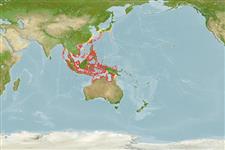>
Ovalentaria/misc (Various families in series Ovalentaria) >
Pomacentridae (Damselfishes) > Pomacentrinae
Etymology: Amphiprion: Greek, amphi = on both sides + Greek, prion, -onos = saw (Ref. 45335).
More on author: Cuvier.
Environment: milieu / climate zone / depth range / distribution range
Ökologie
seewasser riff-verbunden; standorttreu; tiefenbereich 1 - 15 m (Ref. 7247), usually 3 - 15 m (Ref. 55267). Tropical; 46°N - 17°S, 92°E - 147°E (Ref. 55267)
Indo-West Pacific: eastern Indian Ocean including Andaman and Nicobar Islands, Thailand, Malaysia, and northwest Australia to Singapore, Indonesia, and the Philippines; ranges north to Taiwan and the Ryukyu Islands.
Size / Gewicht / Alter
Maturity: Lm ? range ? - ? cm
Max length : 11.0 cm TL Männchen/unbestimmt; (Ref. 9710)
Rückenflossenstacheln (insgesamt): 10 - 11; Rückenflossenweichstrahlen (insgesamt): 13-17; Afterflossenstacheln 2; Afterflossenweichstrahlen: 11 - 13.
Adults inhabit coral reefs where it lives among the venomous tentacles of large sea anemones (Ref. 85309). Occur in shallow and calm lagoons. Are protandrous hermaphrodites (Ref. 32167). Distinct pair is monogamous (Ref. 32167). Oviparous, distinct pairing during breeding (Ref. 205). Eggs are demersal and adhere to the substrate (Ref. 205). Males guard and aerate the eggs (Ref. 205). One of the most popular marine aquarium fishes. Bred artificially in Florida for the aquarium trade. Associated with the anemones: Heteractis magnifica, Stichodactyla gigantea, and Stichodactyla mertensii (Ref. 5911). Has been reared in captivity (Ref. 35410, 35413, 35415, 35418, 35420). Has reached an age of 12 years in captivity (Alexandre Fontayne, pers. comm., 2006).
Life cycle and mating behavior
Geschlechtsreife | Fortpflanzung | Ablaichen | Eier | Fecundity | Larven
Benthic spawner. Length at sex change = 4.4 cm TL (Ref. 55367). Oviparous, distinct pairing during breeding (Ref. 205). Eggs are demersal and adhere to the substrate (Ref. 205). Males guard and aerate the eggs (Ref. 205). Also Refs. 240, 7471, 118437.
Allen, G.R., 1991. Damselfishes of the world. Mergus Publishers, Melle, Germany. 271 p. (Ref. 7247)
IUCN Rote Liste Status (Ref. 130435)
Bedrohung für Menschen
Harmless
Nutzung durch Menschen
Fischereien: nicht kommerziell; Aquarium: Kommerziell
Mehr Information
ReferenzenAquakulturAquakultur ProfilZuchtlinienGenetikElectrophoresesVererbbarkeitKrankheitenVerarbeitungNutrientsMass conversion
Tools
Zusatzinformationen
Download XML
Internet Quellen
Estimates based on models
Preferred temperature (Ref.
123201): 26.2 - 29.3, mean 28.7 °C (based on 1746 cells).
Phylogenetic diversity index (Ref.
82804): PD
50 = 0.5000 [Uniqueness, from 0.5 = low to 2.0 = high].
Bayesian length-weight: a=0.01479 (0.00642 - 0.03409), b=3.00 (2.80 - 3.20), in cm total length, based on LWR estimates for this (Sub)family-body shape (Ref.
93245).
Trophic level (Ref.
69278): 3.1 ±0.36 se; based on food items.
Widerstandsfähigkeit (Ref.
120179): hoch, Verdopplung der Population dauert weniger als 15 Monate. (tm<1; Fec=600).
Fishing Vulnerability (Ref.
59153): Low vulnerability (10 of 100).
Nutrients (Ref.
124155): Calcium = 115 [69, 209] mg/100g; Iron = 0.909 [0.558, 1.451] mg/100g; Protein = 18.6 [17.5, 19.6] %; Omega3 = 0.142 [0.086, 0.235] g/100g; Selenium = 18.8 [10.6, 37.0] μg/100g; VitaminA = 223 [75, 636] μg/100g; Zinc = 1.84 [1.26, 2.60] mg/100g (wet weight);
